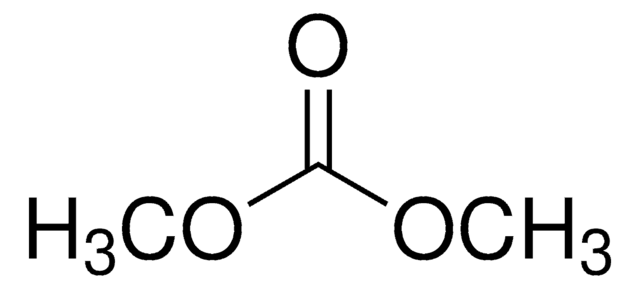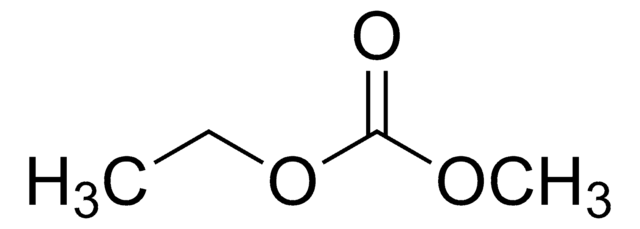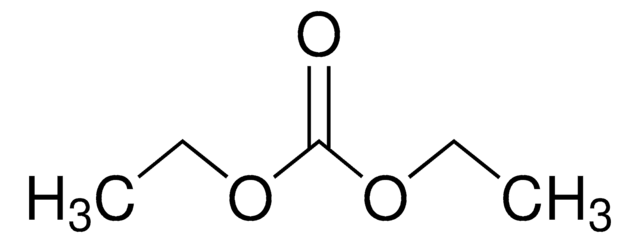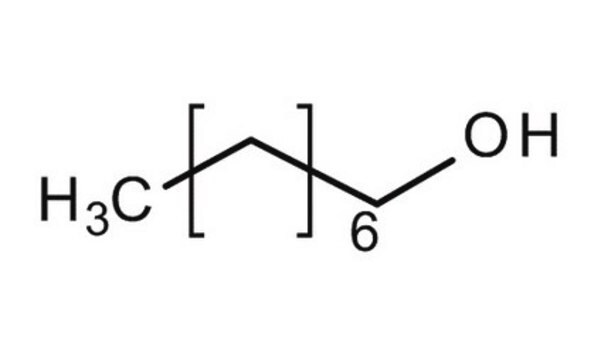8.03525
Dimethyl carbonate
for synthesis
Synonim(y):
Dimethyl carbonate, DMC, Methyl carbonate, Carbonic acid dimethyl ester
About This Item
Polecane produkty
ciśnienie pary
53 hPa ( 20 °C)
Poziom jakości
Próba
≥99.0% (GC)
Formularz
liquid
temp. samozapłonu
458 °C
siła działania
9000 mg/kg LD50, oral (Rat)
>5000 mg/kg LD50, skin (Rabbit)
granice wybuchowości
4.22-12.87 % (v/v)
charakterystyka ekologicznej alternatywy
Less Hazardous Chemical Syntheses
Safer Solvents and Auxiliaries
Design for Degradation
Learn more about the Principles of Green Chemistry.
sustainability
Greener Alternative Product
bp
90 °C/1016 hPa
mp
0.5-4.7 °C
temp. przejścia
flash point 16.7 °C
rozpuszczalność
139 g/L
gęstość
1.07 g/cm3 at 20 °C
kategoria ekologicznej alternatywy
, Aligned
temp. przechowywania
2-30°C
ciąg SMILES
O(C)C(=O)OC
InChI
1S/C3H6O3/c1-5-3(4)6-2/h1-2H3
Klucz InChI
IEJIGPNLZYLLBP-UHFFFAOYSA-N
Opis ogólny
Zastosowanie
- Unraveling the Irreversible Storage of Dimethyl Carbonate-Solvated Hexafluorophosphate Anions in Graphite Electrode.: This study explores the irreversible storage mechanisms of dimethyl carbonate in graphite electrodes, crucial for enhancing electrochemical applications (Liu et al., 2024).
- Electronic interaction between dimethyl carbonate and Li(+) studied by attenuated total reflectance far-ultraviolet spectroscopy.: This research provides insights into the electronic interactions of dimethyl carbonate with lithium ions, important for developing better electrolytes in battery technology (Sato et al., 2024).
- Glycerol carbonate synthesis via transesterification of enriched glycerol and dimethyl carbonate using a Li-incorporated MCM-41 framework.: This paper discusses the synthesis of glycerol carbonate through transesterification, highlighting the role of dimethyl carbonate in green chemistry applications (Jitjamnong et al., 2024).
- Dimethyl carbonate as a green alternative to acetonitrile in reversed-phase liquid chromatography. Part II: Purification of a therapeutic peptide.: This research examines the use of dimethyl carbonate as a sustainable solvent alternative in the purification processes of pharmaceutical compounds (Bozza et al., 2024).
Komentarz do analizy
Density (d 20 °C/ 4 °C): 1.068 - 1.070
Identity (IR): passes test
Hasło ostrzegawcze
Danger
Zwroty wskazujące rodzaj zagrożenia
Zwroty wskazujące środki ostrożności
Klasyfikacja zagrożeń
Flam. Liq. 2
Kod klasy składowania
3 - Flammable liquids
Klasa zagrożenia wodnego (WGK)
WGK 1
Temperatura zapłonu (°F)
60.8 °F - closed cup
Temperatura zapłonu (°C)
16 °C - closed cup
Certyfikaty analizy (CoA)
Poszukaj Certyfikaty analizy (CoA), wpisując numer partii/serii produktów. Numery serii i partii można znaleźć na etykiecie produktu po słowach „seria” lub „partia”.
Masz już ten produkt?
Dokumenty związane z niedawno zakupionymi produktami zostały zamieszczone w Bibliotece dokumentów.
Klienci oglądali również te produkty
Nasz zespół naukowców ma doświadczenie we wszystkich obszarach badań, w tym w naukach przyrodniczych, materiałoznawstwie, syntezie chemicznej, chromatografii, analityce i wielu innych dziedzinach.
Skontaktuj się z zespołem ds. pomocy technicznej







![1,8-Diazabicyclo[5.4.0]undec-7-ene for synthesis](/deepweb/assets/sigmaaldrich/product/images/219/652/f12d7266-2d82-4869-9d8d-919b0f68de68/640/f12d7266-2d82-4869-9d8d-919b0f68de68.jpg)
